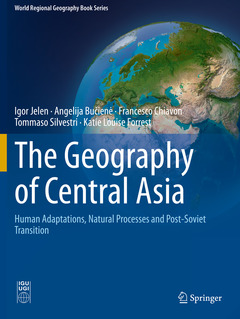Description
The Geography of Central Asia, 1st ed. 2020
Human Adaptations, Natural Processes and Post-Soviet Transition
World Regional Geography Book Series
Language: English
Subjects for The Geography of Central Asia:
Keywords
Anthropogenic Effects on Natural Environments; Culture-Nature Interactions in Central Asia; Geography of Kazakhstan; Geography of Uzbekistan; Geography of Turkmenistan; Geography of Kyrgyzstan; Geography of Tajikistan; Global- and Local-Scale Tensions; Human Adaptation in Extreme Environments; Impacts of Ideologies and Technologies on Territories; Physical and Human Geography of Central Asia; world regional geography
Publication date: 03-2022
358 p. · 21x27.9 cm · Paperback
Publication date: 03-2021
358 p. · 21x27.9 cm · Hardback
Description
/li>Contents
/li>Biography
/li>Comment
/li>
This book provides a profound geographical description and analysis of Central Asia. The authors take a synthetic approach in a period of critical transformation in the post-soviet time. The monograph analyzes comprehensively the physical and human geography as well as human-nature interactions of Central Asia with focus on Kazakhstan, Uzbekistan, Turkmenistan, Kyrgyzstan and Tajikistan. Natural processes are described at a systemic scale, focusing on ecological impacts and consequences and contemporary human adaptations and organization. It also discusses in which ways the human organizations try to apply solutions for their needs such as security, territorial management and resources renewability, material and functional needs, identity elaborations, culture and communication.
The Geography of Central Asia appeals to scientists and students of regional geography and interested academics from other areas such as social, political, economic and environmental studies within the context of Central Asia. The book is also a very useful resource for field trips into this area.
Preface.- Acknowledgement.- Chapter 1. Premise: a land of extremes.- Chapter 2. The geographical setting and physical environment.- Chapter 3. Geo biology, botanic and biodiversity.- Chapter 4. Ecological base and environmental constraints.- Chapter 5. Modernization and correspondent ecological/ human ruptures.- Chapter 6. Environmental challenges in globalization and post-modern times.- Chapter 7. A historical periodization: from nature to early stages of human settlement, to classic age.- Chapter 8. Modern era and modernization processes until the soviet collapse.- Chapter 9. The geographical mosaic.- Chapter 10. From culture to material aspects.- Chapter 11. The material “container”: structural and infra-structural aspects.- Chapter 12. Economics, from micro to macro.- Chapter 13. Institutions and politics.- Chapter 14. Political geography and geopolitics.- Chapter 15. Final comments.
Igor Jelen is Professor of Political and Economic Geography at the University of Trieste, Italy. After five years in marketing and consulting he worked as a researcher in political and economic geography at the University of Trieste. In 2014 he received the habilitation as a Full Professor. He frequently travelled to the Central Asian post-soviet countries, where he also stayed for extended periods, organizing fieldwork, starting from the early 90’s. His further research topics are peripheral regions, especially remote and mountainous regions around the world, and corresponding development questions, borders and borderland questions and rivalries (e.g. the China-Russian–Central Asian borders), the European Union as well as other regional integration processes (especially form the point of view of security and defence), and globalization issues. Igor Jelen is a founding member of the ASIAC (Associazione per lo studio in Italia dell’Asia Centrale), and member of the editorial board of National Identities and of the Journal of Geography, Politics and Society; in 1992 he was a visiting scholar at the University of South Carolina in Columbia, SC, USA. And in 2011-2012 he was a visiting professor at the Leopold Franzens University of Innsbruck.
Angelija Bučienė is Professor of Physical Geography at Klaipeda University, Lithuania. She received her Diploma in Hydrology at Vilnius University in 1975 and her Scientific Agronomy Diploma at the Lithuanian Agricultural University in 1981, where she also received her Doctorate in 1984. Her habilitation was finished at Vilnius University in 2009.
Her area of expertise are agrohydrology, rural landscape geography, environmental geography and sustainable development. She taught many courses, e.g., geospheres and physical processes, landscape geography and management, physical geography, landscape ecology, regions and regional development, theory an
Provides a unique comprehensive analysis of the not very well-known region of Central Asia
Focuses on dynamic aspects of the changing reality for both human and nature
Represents an effective learning instrument for students of the regional geography of Central Asia and related fields

